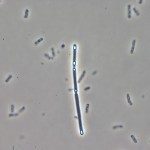Lien vers Pubmed [PMID] – 21685382
J. Biol. Chem. 2011 Aug;286(33):29053-62
The structure of the vegetative cell wall peptidoglycan of Clostridium difficile was determined by analysis of its constituent muropeptides with a combination of reverse-phase high pressure liquid chromatography separation of muropeptides, amino acid analysis, mass spectrometry and tandem mass spectrometry. The structures assigned to 36 muropeptides evidenced several original features in C. difficile vegetative cell peptidoglycan. First, it is characterized by a strikingly high level of N-acetylglucosamine deacetylation. In addition, the majority of dimers (around 75%) contains A(2)pm(3) → A(2)pm(3) (A(2)pm, 2,6-diaminopimelic acid) cross-links and only a minority of the more classical Ala(4) → A(2)pm(3) cross-links. Moreover, a significant amount of muropeptides contains a modified tetrapeptide stem ending in Gly instead of D-Ala(4). Two L,D-transpeptidases homologues encoding genes present in the genome of C. difficile 630 and named ldt(cd1) and ldt(cd2), were inactivated. The inactivation of either ldt(cd1) or ldt(cd2) significantly decreased the abundance of 3-3 cross-links, leading to a marked decrease of peptidoglycan reticulation and demonstrating that both ldt(cd1)-and ldt(cd2)-encoded proteins have a redundant L,D-transpeptidase activity. The contribution of 3-3 cross-links to peptidoglycan synthesis increased in the presence of ampicillin, indicating that this drug does not inhibit the L,D-transpeptidation pathway in C. difficile.

